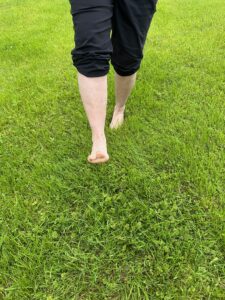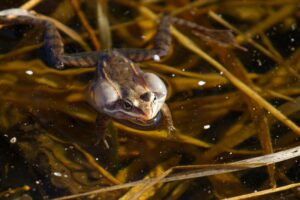By Jessica Johnsrud, education coordinator
In the early summer, the pond near the tower is full of life. There are the usual animals that come to mind, like red-winged blackbirds, mallards, and frogs, but there is a whole ecosystem of small creatures that live in the water itself.
 Dipping for critters in the pond is something all ages enjoy. In fact, Woodland Dunes recently offered a pond dipping class just for adults, and the participants were tickled with their discoveries. Much like the children and families that partake in this popular activity, the adults were just as enthusiastic.
Dipping for critters in the pond is something all ages enjoy. In fact, Woodland Dunes recently offered a pond dipping class just for adults, and the participants were tickled with their discoveries. Much like the children and families that partake in this popular activity, the adults were just as enthusiastic.
After demonstrating how to safely dip, how to carefully handle the creatures, and giving a few pointers, everyone grabbed a small net and immediately started. After just a few short minutes, I heard noises of surprise and laughter. One adult exclaimed “Ooh, I got a tadpole!” and another repeated several times, “This is so cool! I’m going to bring my grandkids here to do this with them.”
Even the youngest children love to scoop in the pond. The same week of the adult pond dipping class, the Wild Child classes also dipped for dragonfly larva. These kids were 2-5 years old and had an adult with them. Many needed some help with the mechanics of dipping, but their little eagle eyes were adept at spotting the small, camouflaged critters in their net. They were all delighted with their discoveries and enjoyed watching the creatures swim and move through the water in the collection bin.
What did these groups find in the pond? A wide variety of animals! Dragonflies start their lives in a larval stage in the water and they are abundant in the pond in early summer. Dragonfly larva (also called nymphs or naiads) are one of my favorites because of their large, alien-like eyes, and as they grow, you can see their wing buds.
They also found some of the aquatic beetles including the crawling water beetle, a backswimmer, and the water scavenger beetle. There are several other kinds of water beetles that turn up in the pond as the summer continues. Beetles are the most common group of insects in Wisconsin.
Other creatures observed in the water were: American toad tadpoles, green frog or northern leopard frog tadpoles (it’s difficult to tell between these two species when they are early-stage tadpoles), a young northern pike that was about 3 inches long, a painted turtle, and a muskrat.
Pond dipping definitely brings out our inner child and invocates a sense of curiosity and wonder. If you’d like to give it a try, there are pond dipping nets, containers, and identification charts in our family room that you can use while the Nature Center is open.
photo of dragonfly nymph by Kennedy Zittel




